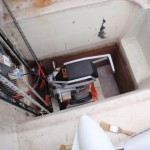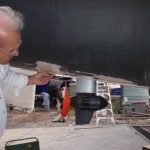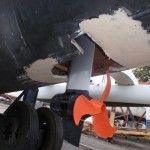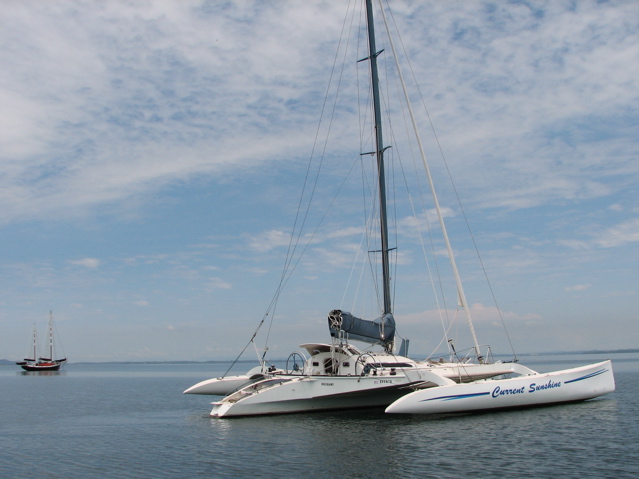I’m selling my Epod – the details are here. If you’re interested you can write to me at chris at currentsunshine.com, or by using the comment facility on this page. (don’t worry, it will be kept private – just in case you’re thinking all comments show up publicly). I’ve now listed it on Ebay
On the slip again
This time the main project is fitting the Torqeedo, and I also have some repairs from flood damage to complete. I have about another week until the yard will put her back in the water.
Claude dropped by to see how the installation is progressing and to offer advice – he also took a few pics…
 The top of the Torqeedo looks way too small for someone used to the size of petrol outboards. It means I have plenty of space in the well to fit it in, and room for adding lines and blocks for steering. I’ll connect it to the main steering so that it works in unison with the rudder.
The top of the Torqeedo looks way too small for someone used to the size of petrol outboards. It means I have plenty of space in the well to fit it in, and room for adding lines and blocks for steering. I’ll connect it to the main steering so that it works in unison with the rudder.
Claude lent me the book on propellers and it suggests that we need a minimum of 50mm clearance to the hull. Claude is holding a batten along the hull line to show how much clearance we have with the motor lowered to its working height. (Click picture for bigger image).
Look how small the motor is! The black pod is the electric motor and a reduction gear box – its amazingly small considering what thrust it produces. The Epod was much bigger than this and it means that I can reduce the size of the opening in the well.
 Here’s another photo showing it from the port quarter, and you can see the new work I’ve done to reduce the size of the opening. The pink areas are the fill-in work that I’ve done. You can see how fine the prop is – I think this is part of the reason its so efficient – the fineness of the prop means it has very little friction.
Here’s another photo showing it from the port quarter, and you can see the new work I’ve done to reduce the size of the opening. The pink areas are the fill-in work that I’ve done. You can see how fine the prop is – I think this is part of the reason its so efficient – the fineness of the prop means it has very little friction.
My mission now is to make some flaps or a wing to block the hole when the motor is down, and also when its hauled up and the boat is under sail.
A breath of fresh air…
I ordered the Torqeedo on Tuesday, and Claude delivered it on Wednesday. And we installed it and it worked perfectly first time. What a breath of fresh to have things work as they should.
She was to be slipped at 4pm and so Claude brought the motor here early enough so we could go up the river beforehand and do some more tests.
This time we had three on board – the third being Phil from Dragon Song, one the inmates here at Monty’s, trapped here by contagious apathy. And this time I remembered to pull the centreboard up to reduce drag even more.
I added a piece of hardwood to the outboard bracket, which moved the mounting a little to the stern, and we adjusted the angle of the motor to what we thought to be most efficient.
Going with the tide we hit 7.5 knots, and the best we saw coming back was 5.9. This would suggest a current of 0.8 knots going upstream, and so that makes the still water speed 6.7 knots.
Later we tinkered with raising and lowering the centre-board and it makes a difference of 0.3 to 0.4 knots.
Because the well is open at the bottom, the water sloshes around, and when under lots of power it boils around in there, absorbing quite a lot of power. So there’s even more scope for better speed after I make a blocking wing to seal the hole.
And that’s the main reason she’s now out of the water on the trolly (again!). It’ll take quite a few days to figure out and build suitable wings or flaps to block the hole when the motor is up, and down. But it also gives me a chance to complete the repairs from the flood damage. Even on sunny days there’s a heavy dew till late morning, and this dampness has made it difficult to properly dry out the balsa core before doing the repairs. On the hard it will be easier to set up heater fans to get it properly dry.
In the tests we tried the motor at different throttle settings and think we found a ‘sweet spot’ for this boat – at around 1500 watts she lopes along at around 4.5 knots. This is a nice speed, and the batteries have enough to energy to do this for 5 or 6 hours.
These figures confirm that this motor is about twice as efficient as the Epod. That is, at a particular speed I would get twice the range with the Torqeedo. Or looking at it another way, switching to the Torqeedo is equivalent to adding another bank of batteries. And at ten thousand dollars a bank, its a good investment huh.
The motor we tested a few days ago was off Claude’s boat, and the one I have now is new, out of the box. And its seems there’s slight differences in settings of the controller – because with this controller we saw much better power astern. This controller showed up to 3000 watts of power, so I’m pleased with that.
Claude suggests there’s more to it, because the controller is clever enough to sense when there is cavitation of the prop and it automatically reduces power to allow the prop to grip. And thats the effect we saw the other day with the lower readings. Understanding that better will have to wait until I’m back in the water.
